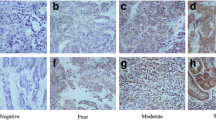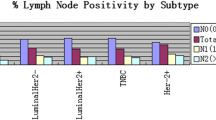Abstract
The objective of this study was to investigate the expression and significance of the GRHL3 protein in breast cancer diagnosis and prognosis. Overall, 111 patients with histologically confirmed breast cancer who had undergone radical surgery were enrolled in this study. The GRHL3 protein expression status in the breast cancers was evaluated by immunohistochemistry. The relationship between GRHL3 protein expression status and clinicopathological factors and the breast cancer prognoses was also determined. In total, 71 (63.96 %) out of 111 cases were found to express GRHL3 protein. GRHL3 expression was higher in breast cancers, compared to other pathologic cancer types (χ 2 = 5.68, P < 0.05). Moreover, GRHL3 protein was also observed to correlate with breast cancer clinical stage and histological grade (χ 2 = 7.99, P < 0.05 and χ 2 = 7.907, P < 0.05, respectively). Interestingly, triple-negative breast cancers had lower expression rates than other breast cancers (41.18 vs. 71.28 %, P < 0.05). GRHL3 was shown to be an independent prognostic factor of breast cancer in Cox regression analysis. Altogether, our results indicate predominant GRHL3 expression in breast cancers, especially non-triple-negative cancers and early stage cancers. GRHL3 expression appeared to decrease with tumor progression. Survival analysis demonstrated the inhibitory effect of GRHL3 in breast cancer. These results strongly suggest the possible involvement of GRHL3 in tumor suppression.


Similar content being viewed by others
References
Rody A, Diallo R, Poremba C, et al. Estrogen receptor alpha and beta, progesterone receptor, pS2 and HER-2 ⁄ neu expression delineate different subgroups in ductal carcinoma in situ of the breast. Oncol Rep. 2004;12:695–9.
Yu Z, Lin KK, Bhandari A, Spencer JA, Xu X, Wang N, et al. The grainyhead-like epithelial transactivator Get-1/Grhl3 regulates epidermal terminal differentiation and interacts functionally with LMO4. Dev Biol. 2006;299:122–36.
Darido C, Georgy SR, Wilanowski T, Dworkin S, Auden A, Zhao Q, et al. Targeting of the tumor suppressor GRHL3 by a miR-21-dependent proto-oncogenic network results in PTEN loss and tumorigenesis. Cancer Cell. 2011;20:635–48.
Guardiola-Serrano F, Haendeler J, Lukosz M, Sturm K, von Melchner H, Altschmied J. Gene trapping identifies a putative tumor suppressor and a new inducer of cell migration. Biochem Biophys Res Commun. 2008;376:748–52.
Selvaggi G, Scagliotti GV. Histologic subtype in NSCLC: does it matter? Oncology (Willson Park). 2009;13:1133–40.
Chen KT, Lee TW, Lo JM. In vivo examination of 188Re(I)-tricarbonyl-labeled trastuzumab to target HER2-overexpressing breast cancer. Nucl Med Biol. 2009;36:355–61.
Jacquemier J, Charafe-Jauffret E, Monville F, et al. Association of GATA3, P53, Ki67 status and vascular peritumoral invasion are strongly prognostic in luminal breast cancer. Breast Cancer Res. 2009;11:R23.
Vora HH, Patel NA, Rajvik KN, et al. Cytokeratin and vimentin expression in breast cancer. Int J Biol Markers. 2009;24:38–46.
Darido C, Jane SM. Grhl3 and GEF19 in the front rho. Small GTPases Landes Bioscience. 2010;1(2):104–7.
Ting SB, Wilanowski T, Cerruti L, Zhao LL, Cunningham JM, Jane SM. The identification and characterization of human Sister-of-Mammalian Grainyhead (SOM) expands the grainyhead-like family of developmental transcription factors. Biochem J. 2003;370:953–62.
Hislop NR, Caddy J, Ting SB, Auden A, Vasudevan S, King SL, et al. Grhl3 and Lmo4 play coordinate roles in epidermal migration. Dev Biol. 2008;321:263–72.
Ting SB, Wilanowski T, Auden A, Hall M, Voss AK, Thomas T, et al. Inositol- and folate-resistant neural tube defects in mice lacking the epithelial-specific factor Grhl-3. Nat Med. 2003;9:1513–9.
Ting SB, Caddy J, Hislop N, Wilanowski T, Auden A, Zhao LL, et al. A homolog of Drosophila grainy head is essential for epidermal integrity in mice. Science. 2005;308:411–3.
Panis C, Pizzatti L, Herrera AC, Cecchini R, Abdelhay E. Putative circulating markers of the early and advanced stages of breast cancer identified by high-resolution label-free proteomics. Cancer Lett. 2012;330:57–66.
Acknowledgments
This work was supported by the National Nature Science Foundation of China (nos. 81102029 and 81172047).
Conflicts of interest
None
Author information
Authors and Affiliations
Corresponding authors
Rights and permissions
About this article
Cite this article
Xu, H., Liu, C., Zhao, Z. et al. Clinical implications of GRHL3 protein expression in breast cancer. Tumor Biol. 35, 1827–1831 (2014). https://doi.org/10.1007/s13277-013-1244-7
Received:
Accepted:
Published:
Issue Date:
DOI: https://doi.org/10.1007/s13277-013-1244-7




